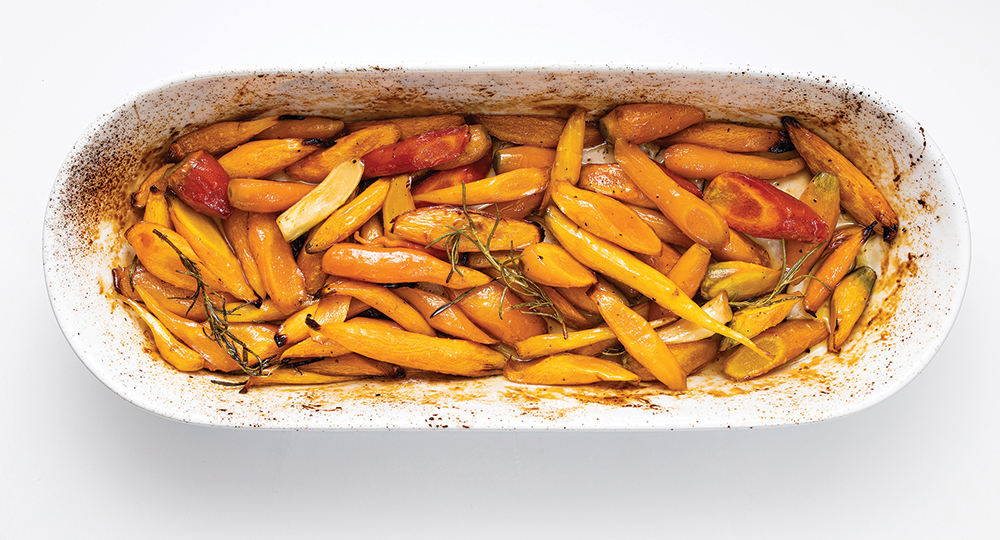
We all take them for granted. They hang out in the vegetable drawer for ages, reliably orange, usually crunchy and sweet until cooked. They seldom cause mischief other than going limp and occasionally growing a few little hair-like roots—but otherwise, they’re a bit like kitchen wallpaper. They don’t need to be. A good carrot deserves to be the center of attention every now and then.
As children, raw carrots are often the first vegetable we learn to request—after mashed potatoes, of course, which don’t in any way seem much like a vegetable. I would only eat them raw until when I was in college and living in Europe, when my culinary curiosity was growing by leaps and bounds. There were wonderful salads of grated, dressed carrots, carrots braised with meats that seemed even more delicious than the meat itself, pickled carrots, carrot purees, carrots in vinaigrette—it seemed everywhere I traveled there were amazing expressions of the carrot. I wanted to cook them, and I wanted to grow my own.
Over the years and in various gardens, I have tried to grow them, usually without any measure of success. This year during the lockdown I discovered a technique on YouTube for getting carrot seeds to reliably germinate—scatter the seeds in a row on dampened soil and then cover them with a board. You leave them covered for one to two weeks (lightly watering if the soil dries out), checking every few days, and then when you see the first tiny seedlings, prop the board up a half an inch for the next two days so they can expand. Remove the board and voila—carrots! The following months involved occasional watering and the obligatory and impatient extraction of a specimen while monitoring growth. When my first carrot harvest of the pandemic materialized, I couldn’t wait to get it into the kitchen. The taste of freshly dug carrots can be a bit of a shock. In my experience they tend to be less sweet than the mammoth grocery store carrots we are accustomed to but have a much more interesting and carroty flavor and depth. I grew several types including some of the shorter cylindrical Nantes varieties (good for our area soil) and a colorful selection called “Carnival Blend” which includes a number of very old carrot varieties ranging in color from whites, yellows, reds, and oranges all the way to a deep purple. For gardeners with deep sandy soil and a desire to grow gigantic, super sweet roots, try Imperator. These monsters are frequently used in industrial kitchens and can occasion the type of restaurant-kitchen humor that causes HR directors to shudder.
Carrots that are less than ideal (a little wilty, maybe not so sweet or oddly sized) can be enhanced by cooking, especially roasting. And if you’ve gone to the expense of buying fresh carrots with tops or have gone to the trouble of growing your own, don’t neglect the fluffy carrot greens. Remove them before storing—if left attached they will cause the carrots to wilt in a surprisingly short amount of time. The tops can be made into a lovely vegetal pesto good for dressing pasta or as a dip for vegetables. Please, in the spirit of pandemic cooking, use every part of the carrot. Think of the carrot as an essential worker, a quiet hero in the kitchen often overlooked, but deserving of our attention and respect.
Brown Sugar and Rosemary Roasted Carrots
Roasting root vegetables, especially carrots, concentrates their flavors and natural sugars—but that doesn’t mean they don’t need a little extra somethin’ every now and then. A coworker of mine introduced me to this technique years ago when preparing staff meal. Everyone loved it, and the preparation could not have been simpler. Prepare your carrots by peeling (unless very small) and slicing them into similar sized segments. In a bowl, drizzle them with enough olive oil or melted butter to generously coat them, then season with salt and pepper and a few sprigs of rosemary. Add a responsible amount of brown sugar (let’s say approximately ¼ cup sugar for a pound of carrots). Toss them repeatedly until the carrots are completely coated and the brown sugar begins to dissolve. Pour the dressed carrots into a baking dish or onto a sheet pan and roast in a 400F oven for about 35 minutes, stirring every ten minutes or so. The carrots will begin to shrivel and develop lightly singed edges. If you stop now, you will have tasty carrots that look approximately like the photo. They are at their prettiest at this point. However—if you continue to roast and stir them for about 20 to 30 more minutes, your carrots can become something even more marvelous. They become withered, lightly charred on many of the edges, and develop a pleasant, almost leathery texture. The carrot flavor and sweetness attain another level of complexity with the rosemary adding an almost meaty savory-ness to the dish. I have tried to rush the procedure by first blanching the carrots then finishing them in a very hot oven, but the end result isn’t worth the minutes saved. Serve the carrots warm or at room temperature. Leftovers can be tossed with a vinaigrette and served alone or as a sweet and toothsome element to a composed salad. Enjoy.
In Your Pantry
Brown and Sweet
All of these sugars insist they can be substituted one to one for white sugar, but persnickety cooks disagree. The most important thing to consider when using these sugars as substitutes for standard white sugar is the amount of moisture they contain. Generally speaking, the darker the sugar, the higher the moisture content.

Brown Sugar
The standard for complex and delicious sweetening, this one is great for raw, liquid and cooked applications. Brown sugar may be either unrefined or partially refined sugar with residual molasses or refined white sugar that has the addition of molasses to achieve its flavor and color. Percentage of molasses (3.5-6.5%) determines whether the sugar is designated Light or Dark Brown, the darker having a more intensely molasses-y flavor. Naturally hygroscopic, it is normally soft but may harden in extremely dry conditions (AKA ages in your pantry in just a plastic bag that isn’t tightly sealed). To return it to softness, try either briefly microwaving for immediate use, or placing a slice or two of apple in the bag with the sugar and letting the sugar slowly rehydrate for a few days. When “fresh” and stored in a properly sealed container, this sugar has the highest moisture content.
Turbinado Sugar
AKA Sugar in the Raw, is made from partially evaporated sugar-cane juice from the first pressing of sugar cane that is then spun in a centrifuge (“turbine,” thus the name) to remove most of the molasses. This process results in large, golden-brown crystals. Turbinado sugar has a lower moisture content than brown sugar but a higher one than regular white processed sugar, so substituting in recipes can be a bit tricky with this one. A favorite of drinkers of sweet coffee and for topping baked goods.
Brown Coconut Sugar
The most like traditional brown sugar and a little more nutritionally sound than other refined sugars. Coconut Sugar is made by farmers who cut into flower-bud stems of the coconut tree to allow the nectar to flow out which is mixed with water and boiled down to a syrup. It is then dried and allowed to crystallize, then broken into granule size. In addition to trace elements and nutrients, it purports to have a lower glycemic index. It has a nice, nutty caramel taste, performs well in all cooking and raw applications.
Date Sugar
The least like standard brown sugar or white sugar, Date Sugar is made by dehydrating dates (which are very sweet) and then grinding them to the consistency of sugar granules. It does not dissolve in liquid so don’t use it for your next cocktail or to sweeten your next batch of ice cream. The most practical application is baking in something with a whole-grain texture, so the texture of the ground dates isn’t distracting. Perfect for tree-hugging earthy-crunchy bakers who like to make muffins that are supposed to be good for you.


